VCU research: rapid evolution to integration and domain control
OEMs gradually realize independent supply amid the competitive landscape of VCUs for new energy passenger cars
The VCU is the "brain" of new energy vehicles. In the early development stage of China's new energy vehicle industry, VCUs were mainly supplied by foreign vendors. Afterwards, domestic automakers and automotive electronics suppliers have gradually mastered core technologies, so that their industrialization capabilities were greatly improved.
For example, BYD has fully realized independent supply of VCUs, Geely has continuously increased the proportion of self-produced VCUs to about 60%, almost 80% of Changan Automobile’s VCUs are produced by itself, and Chery can produce more than 90% of its own VCUs.
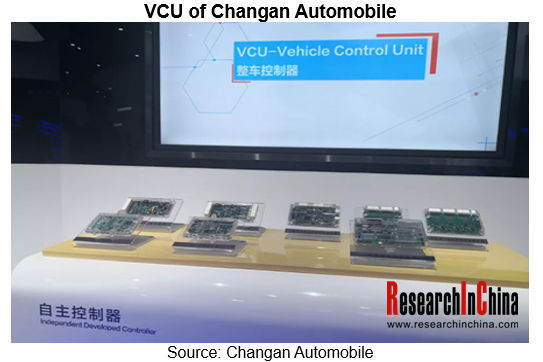
The VCUs of some OEMs or some models are purchased from third-party suppliers like UAES, Bosch, Continental, Denso, G-Pulse Electronics Technology, Atech, Hefei Softec Auto Electronic, Hangsheng Electronics, etc. Suppliers can provide their own software and hardware directly to OEMs, or they can be the foundries of OEMs.
The VCU market size is related to the output of new energy vehicles. By 2025, China new energy vehicle VCU market size will hit RMB5.03 billion (including self-supply of automakers).
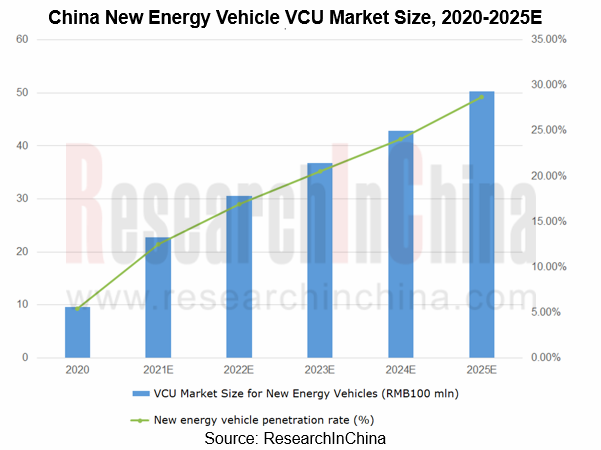
Lightweight promotes the development of "electric drive + electric control + VCU" integrated system
In order to cater to the development trend of electrified, intelligent and lightweight vehicles, VCUs will tend to be highly integrated in the future. OEMs and Tier 1 suppliers have launched "all-in-one" electric drive systems, containing VCUs.
To further reduce the weight of new energy vehicles, improve product performance and ride comfort, BAIC started to try highly integrated products, followed by GM, Huawei, BYD, etc.. "Electric drive + electronic control + VCU" integrated systems have become the focus of OEMs and Tier 1 suppliers.
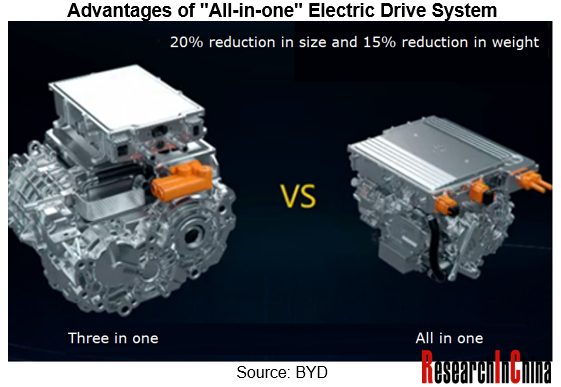
In September 2021, FinDreams Powertrain under BYD launched the "eight-in-one" electric powertrain, which deeply integrates drive motor, motor controller, reducer, automotive charger, DC converter, power distribution box, VCU, and battery manager.
One of the main purposes of BYD's "eight-in-one" integrated system is to reduce the weight of electric vehicles. It can realize the sharing of external high-voltage filters, external interface filter circuits and high-voltage sampling, as well as the in-depth integration of system DC, OBC, power distribution, transformers, inductors and VCU/BMC/MCU chips, so that an H-Bridge, transformers and a lot of high-voltage wiring harness are unnecessary, the magnetic module size is reduced by 40%, the overall volume is cut down by 16% (which can expand the riding space or increase the battery capacity), and the weight is slashed by 10% (which can further reduce power consumption).
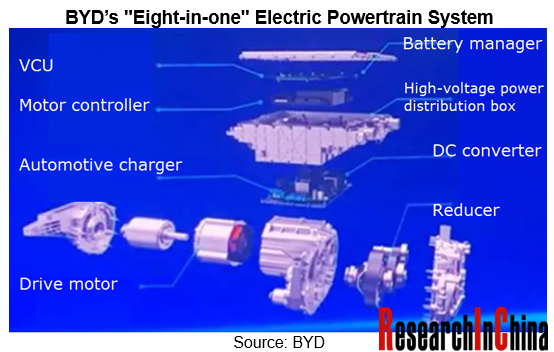
In July 2021, Changan Automobile released the second-generation electric drive integrated system, which combines seven components: VCU, high-voltage junction box, motor controller, DC converter, charger, motor, and reducer. Compared with the first-generation "three-in-one" (integrated motor, electronic control, and reducer) system, the second generation has been significantly improved in comprehensive performance, with the size reduced by 5%, the weight reduced by 10%, the power density increased by 37%, and the efficiency improved by 5%.
Changan Automobile expects to mass-produce next-generation super integrated electric drive in the second quarter of 2022, and which will be first deployed on C385, the first strategic model of the dedicated electric platform (EAP1).
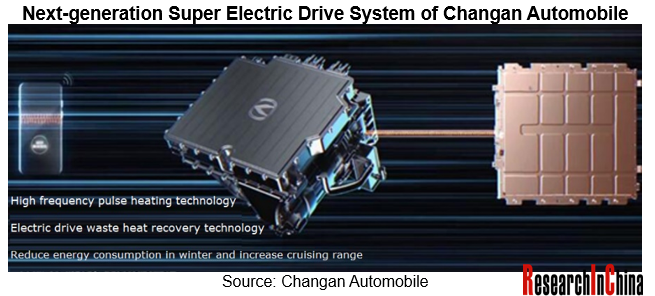
Under the new EEA, VCU develops towards domain control integration
From the perspective of evolution process, automotive E/E architecture (EEA) will inevitably develop towards centralized EEA. From the perspective of mass-produced models, domain-centralized EEA prevail now. The quasi-central architecture consisting of the central computing platform + zonal controllers will be the next step for automakers who finally evolve towards the central computing architecture concentrating the functional logic to a central controller.
With the evolution of the vehicle's EEA, the "all-in-one" electric drive system will eventually be integrated into the domain control system. For example, Huawei's "seven-in-one" DriveONE electric drive system has the most eye-catching domain control solution. The integration of modules, systems, scenarios and solutions effectively improves the system security.
(1) VCUs are integrated into domain controllers
For the development of vehicle EEA, the VCUs of the domain control architecture can be integrated into domain controllers. For example, ENOVATE integrates VCU and BMS to form the first-generation power domain controller VBU with completely independent research and development.
Hardware: The VBU uses Infineon's tri-core processor, has rich I/O resources, and supports Fast Ethernet;
Software: AUTOSAR architecture. The software architecture and interface protocol comply with AUTOSAR 4.2.2;
Application: At present, the VBU has integrated vehicle control, battery management, charging control, and extended range control.
Huawei's CC architecture includes 3 central controllers (smart cockpit, vehicle control, and smart driving) and 4 zonal controllers. Among them, the vehicle domain control (VDC) integrates the original VCU, adopts VOS system, and is compatible with AutoSar.
On the VDC platform, Huawei will develop an MCU and a vehicle control operating system which will be open to automakers, allowing automakers to perform differentiated vehicle control based on the VDC platform.
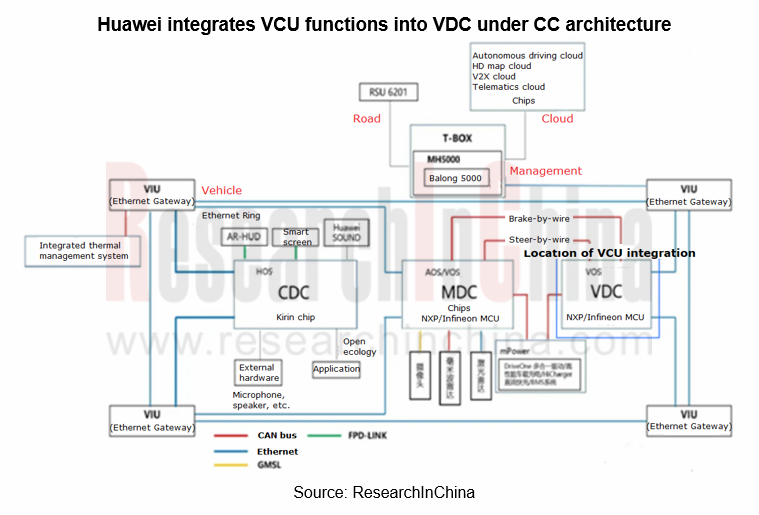
In April 2021, BYD released the e-platform 3.0, which gradually integrates dozens of ECUs in the vehicle into domain controllers of intelligent power domain, intelligent vehicle control domain, intelligent cockpit domain and intelligent driving domain; wherein, intelligent power domain integrates the control part of VCU, BMS, Inverter, PDU, DC/DC and AC/DC.
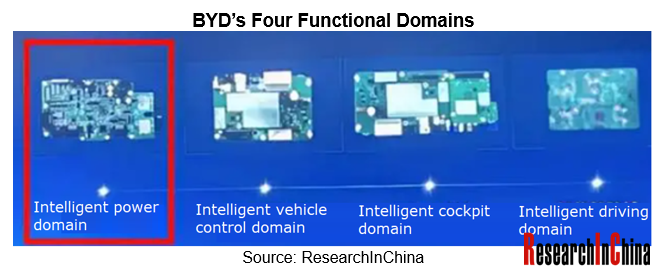
(2) VCUs are integrated into central computing unit
Under the central computing architecture, the central gateway degenerates into multiple zonal gateways, and VCU functions will be integrated into the vehicle control unit of the central computing unit.
For example, Volvo's hybrid central architecture includes a central computing platform, an intelligent interconnection module (IHU), and an autonomous driving module (ADPM) to integrate the original domain controllers into a central computing platform.
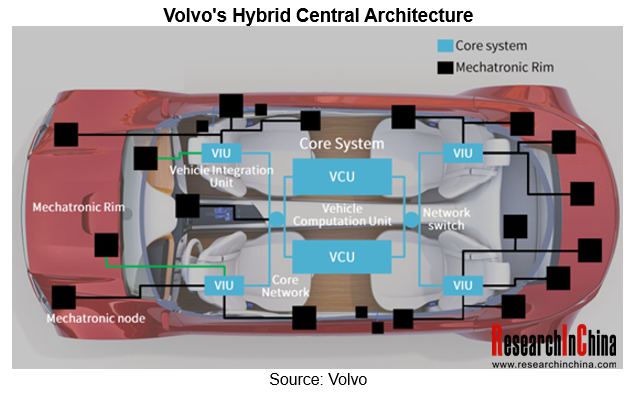
ResearchInChina’s New Energy Vehicle VCU Industry Report, 2021 mainly studies the following contents:
Industry overview, market size, competitive landscape, etc. of VCUs for new energy vehicles;
Industry chain, status quo of upstream and downstream of VCUs for new energy vehicles;
The impact of the EEA reform on VCUs for new energy vehicles, the development trend of VCU technology, etc.;
VCU solutions of some OEMs (such as BYD, ENOVATE, Changan, etc.);
VCU solutions of major domestic and foreign suppliers.
New Energy Vehicle Cross-Domain (Electric Drive System and Powertrain Domain) Integration Trend Report 2025-2026
Electric Drive and Powertrain Domain Research: New technologies such as three-motor four-wheel drive, drive-brake integration, and corner modules are being rapidly installed in vehicles.
Electric dri...
Analysis on Desay SV and Joyson Electronic's Electrification, Connectivity, Intelligence and Sharing, 2025
Research on Desay SV and Joyson Electronic: Who is the No.1 Intelligent Supplier?
Both Desay SV and Joyson Electronic are leading domestic suppliers in automotive intelligence. "Analysis on Desay SV ...
OEMs and Tier 1 Suppliers' Cost Reduction and Efficiency Enhancement Strategy Analysis Report, 2025
ResearchInChina released the "OEMs and Tier 1 Suppliers' Cost Reduction and Efficiency Enhancement Strategy Analysis Report, 2025", summarizing hundreds of cost reduction strategies to provide referen...
Automotive Fixed Panoramic Sunroof and Smart Roof Research Report, 2025
With the intelligent application of car roofs as the core, this report systematically sorts out a series of new products such as fixed panoramic sunroof/openable sunroof, ceiling screen, roof ambient ...
Automotive-Grade Power Semiconductor and Module (SiC, GaN) Industry Research Report, 2025
SiC/GaN Research: Sales volume of 800V+ architecture-based vehicles will increase more than 10 times, and hybrid carbon (SiC+IGBT) power modules are rapidly being deployed in vehicles.
Sales volume o...
Cockpit Agent Engineering Research Report, 2025
Cockpit Agent Engineering Research: Breakthrough from Digital AI to Physical AI
Cockpit Agent Engineering Research Report, 2025 starts with the status quo of cockpit agents, summarizes the technical ...
Prospective Study on L3 Intelligent Driving Technology of OEMs and Tier 1 Suppliers, 2025
L3 Research: The Window of Opportunity Has Arrived - Eight Trends in L3 Layout of OEMs and Tier 1 Suppliers
Through in-depth research on 15 OEMs (including 8 Chinese and 7 foreign OEMs) and 9 Tier 1 ...
China Commercial Vehicle IoV and Intelligent Cockpit Industry Research Report 2025
Commercial Vehicle IoV and Cockpit Research: The Third Wave of Passenger Car/Commercial Vehicle Technology Integration Arrives, and T-Box Integrates e-Call and 15.6-inch for Vehicles
I. The third wav...
Intelligent Vehicle Electronic and Electrical Architecture (EEA) and Technology Supply Chain Construction Strategy Research Report, 2025
E/E Architecture Research: 24 OEMs Deploy Innovative Products from Platform Architectures to Technical Selling Points
According to statistics from ResearchInChina, 802,000 passenger cars with domain...
Research Report on Intelligent Vehicle Cross-Domain Integration Strategies and Innovative Function Scenarios, 2025
Cross-Domain Integration Strategy Research: Automakers' Competition Extends to Cross-Domain Innovative Function Scenarios such as Cockpit-Driving, Powertrain, and Chassis
Cross-domain integration of ...
China Autonomous Driving Data Closed Loop Research Report, 2025
Data Closed-Loop Research: Synthetic Data Accounts for Over 50%, Full-process Automated Toolchain Gradually Implemented
Key Points:From 2023 to 2025, the proportion of synthetic data increased from 2...
Automotive Glass and Smart Glass Research Report, 2025
Automotive Glass Report: Dimmable Glass Offers Active Mode, Penetration Rate Expected to Reach 10% by 2030
ResearchInChina releases the Automotive Glass and Smart Glass Research Report, 2025. This r...
Passenger Car Brake-by-Wire (BBW) Research Report, 2025
Brake-by-Wire: EHB to Be Installed in 12 Million Vehicles in 2025
1. EHB Have Been Installed in over 10 Million Vehicles, A Figure to Hit 12 Million in 2025.
In 2024, the brake-by-wire, Electro-Hydr...
Autonomous Driving Domain Controller and Central Computing Unit (CCU) Industry Report, 2025
Research on Autonomous Driving Domain Controllers: Monthly Penetration Rate Exceeded 30% for the First Time, and 700T+ Ultrahigh-compute Domain Controller Products Are Rapidly Installed in Vehicles
L...
China Automotive Lighting and Ambient Lighting System Research Report, 2025
Automotive Lighting System Research: In 2025H1, Autonomous Driving System (ADS) Marker Lamps Saw an 11-Fold Year-on-Year Growth and the Installation Rate of Automotive LED Lighting Approached 90...
Ecological Domain and Automotive Hardware Expansion Research Report, 2025
ResearchInChina has released the Ecological Domain and Automotive Hardware Expansion Research Report, 2025, which delves into the application of various automotive extended hardware, supplier ecologic...
Automotive Seating Innovation Technology Trend Research Report, 2025
Automotive Seating Research: With Popularization of Comfort Functions, How to Properly "Stack Functions" for Seating?
This report studies the status quo of seating technologies and functions in aspe...
Research Report on Chinese Suppliers’ Overseas Layout of Intelligent Driving, 2025
Research on Overseas Layout of Intelligent Driving: There Are Multiple Challenges in Overseas Layout, and Light-Asset Cooperation with Foreign Suppliers Emerges as the Optimal Solution at Present
20...